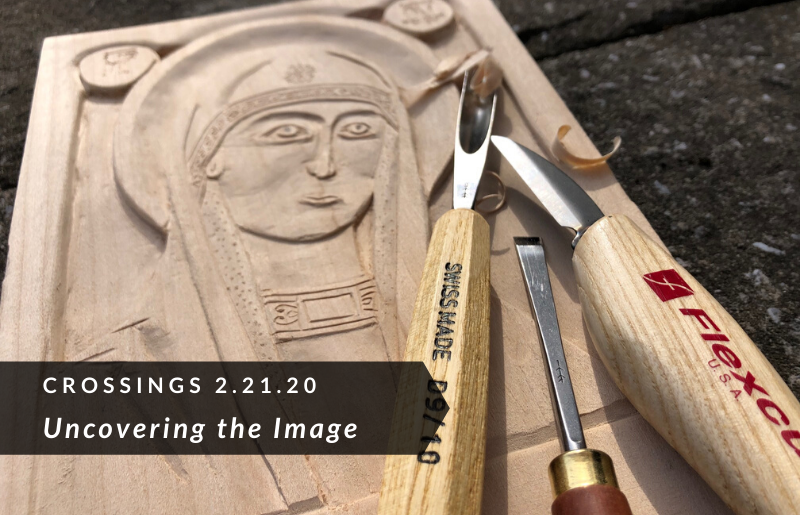By Deacon Samuel
| Recently, I decided that I wanted to take up a new hobby—something creative and hands-on. After some consideration, I stumbled onto some videos of relief carvings, which entail carving an image that appears 3-D onto the surface of a flat plank of wood. I’m a sucker for things which require attention to detail, so I decided to give it a go. I went to a local woodworking shop and got the tools I’d need and a few planks of wood, traced an image onto one of the boards (in this case, an icon of Mary), and got started. I quickly discovered a few things. 1- The process of turning a blank slate into a dynamic picture is slow, tedious, and requires the right tools in the right places. 2- More importantly, I realized the necessity of constantly keeping in mind the image that I set out to carve as I went. It would be very easy to get sidetracked into focusing too much on the different tools and techniques. Sure, these are necessary, but they are the means, not the end. And it is seeing the image that you had in your mind slowly emerge that makes the cost of tools, labor, and bandaids (carving knives are sharp!) worth it. Interestingly, at some point in the process of carving my icon of Mary, I was reminded of a passage in St. Athanasius’ On the Incarnation: For as when a figure painted on wood has been soiled by dirt from outside, it is necessary for him whose figure it is to come again, so that the image can be renewed on the same material—because of his portrait even the material on which it is painted is not cast aside, but the portrait is reinscribed on it. In the same way, the all-holy Son of the Father, being the Image of the Father, came to our place to renew the human being made according to himself, and to find him, as one lost, through the forgiveness of sins.[1] Athanasius describes humanity as a kind of canvass onto which God’s Image is painted—or, to extend the metaphor, as a kind of “plank of wood” into which God’s Image is carved.[1] Behr, John, trans. St Athanasius the Great of Alexandria: On the Incarnation. Popular Patristics Series 44b (Yonkers: St Vladimir’s Seminary Press, 2011), 63-64.Yet, in the Fall, sin and death entered into the picture, and, like a relief carving in reverse, we covered ourselves with all sorts of extra “wood” that doesn’t belong there and only hides the Image that’s carved in us. In fact, we made ourselves like blank planks, and try as we might to draw our own pictures on top, they never really stick; Someone Else’s image is already there, albeit covered. Yet, in Jesus, we see humanity cleared of its excesses and distractions, and in such intimacy with God that it once again radiates the Image imprinted on it. As you know, the season of Lent is approaching, and many of us are planning disciplines. “Tools” like fasting are important because God’s goal for us is to become just like Jesus, recovering and reflecting His perfect Image in our lives, and finding our true selves along the way. And this involves the intentional, tedious, and sometimes painful process of using these “tools” to help remove whatever distracts us from this goal. Lenten disciplines are not about punishing ourselves, but about developing a greater capacity to be living Icons of Christ and to share in the Life for which God made us! As you make your plans for Lent, I encourage you to think and pray carefully about what distracts you or makes it difficult to see and hear God’s voice and presence. This may well mean getting rid of comfort foods or Twitter. But it also might mean carving out more time for prayer (like the Daily Office!), getting a spiritual director, or engaging in acts of almsgiving and service. But remember not to get sidetracked into focusing only on the “tools;” they are but the necessary means to the end of seeing, knowing, loving, and reflecting Christ more deeply in our own lives. As you go about your Lenten labors, keep this goal foremost in your minds. May the Holy Spirit strengthen you in the process. Dcn. Samuel Dcn. Samuel will be in the Prayer Chapel Monday-Friday at 6:30 am & 5:30 pm to pray the Daily Office with anyone who would like to join him. There are also a variety of spiritual formation classes, listed below under “Spiritual Formation Opportunities.” |
Spiritual Formation Opportunities |
| On Being: A Future & A Hope 10 am Sundays Feb. 9- April 26 in the Parish Hall Listening to God Together: An Introduction to Group Spiritual Direction Thurs., Feb. 27-March 26, 7:00-8:30 pm How to Share Your Faith in Today’s Secular Culture Saturday, March 14, 10 am-12:30 pm @ CTR Pray the Daily Office 6:30 am & 5:30 pm Monday-Friday During Lent In the Prayer Chapel |


Recent Comments